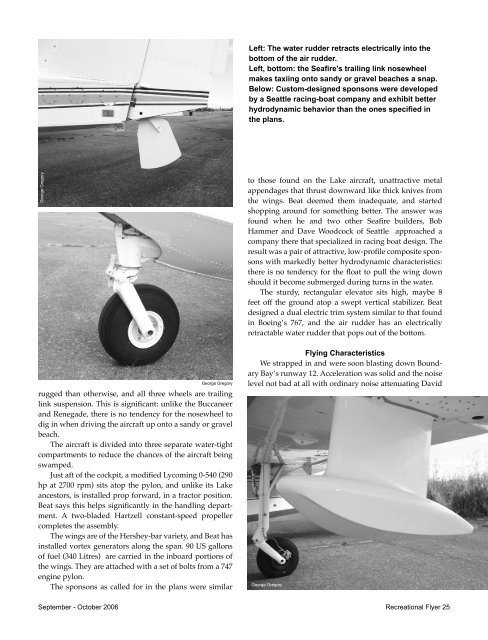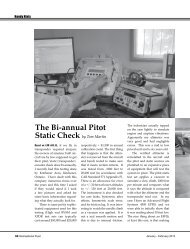September - October - The Recreational Aircraft Association
September - October - The Recreational Aircraft Association
September - October - The Recreational Aircraft Association
Create successful ePaper yourself
Turn your PDF publications into a flip-book with our unique Google optimized e-Paper software.
George Gregory<br />
George Gregory<br />
rugged than otherwise, and all three wheels are trailing<br />
link suspension. This is significant: unlike the Buccaneer<br />
and Renegade, there is no tendency for the nosewheel to<br />
dig in when driving the aircraft up onto a sandy or gravel<br />
beach.<br />
<strong>The</strong> aircraft is divided into three separate water-tight<br />
compartments to reduce the chances of the aircraft being<br />
swamped.<br />
Just aft of the cockpit, a modified Lycoming 0-540 (290<br />
hp at 2700 rpm) sits atop the pylon, and unlike its Lake<br />
ancestors, is installed prop forward, in a tractor position.<br />
Beat says this helps significantly in the handling department.<br />
A two-bladed Hartzell constant-speed propeller<br />
completes the assembly.<br />
<strong>The</strong> wings are of the Hershey-bar variety, and Beat has<br />
installed vortex generators along the span. 90 US gallons<br />
of fuel (340 Litres) are carried in the inboard portions of<br />
the wings. <strong>The</strong>y are attached with a set of bolts from a 747<br />
engine pylon.<br />
<strong>The</strong> sponsons as called for in the plans were similar<br />
Left: <strong>The</strong> water rudder retracts electrically into the<br />
bottom of the air rudder.<br />
Left, bottom: the Seafire's trailing link nosewheel<br />
makes taxiing onto sandy or gravel beaches a snap.<br />
Below: Custom-designed sponsons were developed<br />
by a Seattle racing-boat company and exhibit better<br />
hydrodynamic behavior than the ones specified in<br />
the plans.<br />
to those found on the Lake aircraft, unattractive metal<br />
appendages that thrust downward like thick knives from<br />
the wings. Beat deemed them inadequate, and started<br />
shopping around for something better. <strong>The</strong> answer was<br />
found when he and two other Seafire builders, Bob<br />
Hammer and Dave Woodcock of Seattle approached a<br />
company there that specialized in racing boat design. <strong>The</strong><br />
result was a pair of attractive, low-profile composite sponsons<br />
with markedly better hydrodynamic characteristics:<br />
there is no tendency for the float to pull the wing down<br />
should it become submerged during turns in the water.<br />
<strong>The</strong> sturdy, rectangular elevator sits high, maybe 8<br />
feet off the ground atop a swept vertical stabilizer. Beat<br />
designed a dual electric trim system similar to that found<br />
in Boeing’s 767, and the air rudder has an electrically<br />
retractable water rudder that pops out of the bottom.<br />
Flying Characteristics<br />
We strapped in and were soon blasting down Boundary<br />
Bay’s runway 12. Acceleration was solid and the noise<br />
level not bad at all with ordinary noise attenuating David<br />
George Gregory<br />
<strong>September</strong> - <strong>October</strong> 2006 <strong>Recreational</strong> Flyer 25




